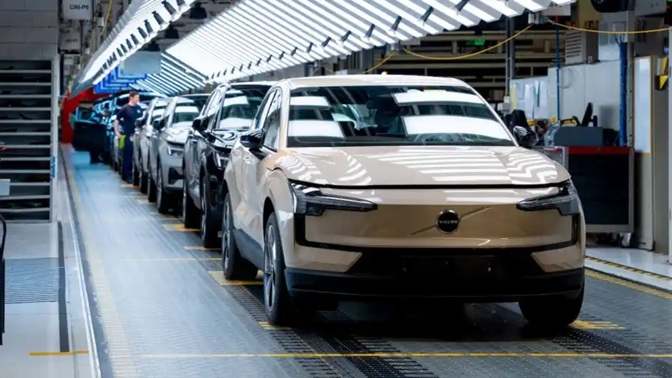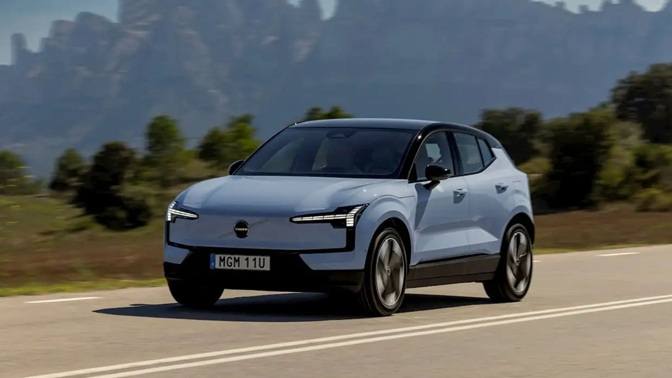Volvo Cars is making bold moves to protect its future and accelerate growth in a rapidly changing global auto industry. The Swedish automaker just announced a massive $2 billion (SEK 18 billion) restructuring strategy, designed to cut costs, streamline operations, and withstand the economic impact of rising tariffs — particularly those introduced under Donald Trump’s trade policies. This isn’t just another business tweak — it’s a sweeping overhaul aimed at keeping Volvo competitive, especially as it launches a new wave of electric vehicles like the EX30 and ES90.

Why Volvo Is Restructuring Now
Volvo’s decision comes after a sharp 60% drop in operating income for the first quarter of 2025. With profits falling to just SEK 1.9 billion, the company has made it clear that it needs to act fast. CEO Håkan Samuelsson put it bluntly: “The automotive industry is in the middle of a very difficult period with challenges not seen before.” He emphasized the urgency of improving cash flow and cutting costs to navigate what he called “turbulence in the market.”
To survive and thrive, Volvo is zooming in on three key pillars:
- Profitability
- Electrification
- Regionalisation
Let’s unpack what each of those means for the company and for car buyers.
Volvo’s restructuring blueprint breaks into three major parts:
- SEK 3 billion (~$280 million) in variable cost reductions, such as streamlining manufacturing and supply chains.
- SEK 5 billion (~$470 million) in indirect spending cuts, including savings in logistics, procurement, and operational efficiency.
- SEK 10 billion (~$940 million) in immediate cash-saving actions aimed at reducing capital expenditures and managing inventory better through 2026.
Most of these savings will be realized over the next year or two. The idea is to free up resources and reinvest in the company’s electric future, while also guarding against economic shocks — like higher import tariffs in the U.S.
Trump-Era Tariffs Force Global Strategy Shift
A big part of Volvo’s restructuring is a response to U.S. tariffs that are expected to affect the cost of imported vehicles and parts. Although Volvo builds some cars in the U.S. — such as the upcoming EX90 SUV in Charleston, South Carolina — many components are still sourced from Europe and Asia.
Even the EX30, which just started production in Belgium, will be imported to the U.S., making it vulnerable to import duties. Volvo knows it needs to adapt quickly, and that’s why it’s reorganizing its global business model.
To do that, Volvo has created a new operational region called the Americas, which now includes the U.S., Canada, and Latin America. The goal is to streamline decision-making, optimize production, and respond faster to trade and regulatory challenges. The company also plans to ramp up production in Charleston, aiming to reduce dependence on overseas parts and avoid tariffs wherever possible.
Despite the rocky financial start to the year, Volvo isn’t slowing down when it comes to electric vehicles. Quite the opposite — it’s doubling down. So far, 43% of Volvo’s Q1 sales came from electrified models, a strong indicator that its EV strategy is gaining traction. And the lineup just keeps growing.
Here’s a look at Volvo’s electric push:
- The EX30, a compact electric SUV, is now in production and expected to boost sales later this year.
- The EX90, a luxury electric SUV, is being assembled in the U.S. but still relies heavily on European parts.
- The newly revealed ES90 sedan is Volvo’s sixth fully electric vehicle, joining the ranks of the EX90, EX30, EX40, and others built on the company’s next-gen tech stack.

In China, Volvo is also preparing to launch its first extended-range plug-in hybrid (PHEV) — an effort to stay competitive in the world’s largest and most fast-moving EV market. Volvo says it remains “firm on becoming a fully electric car company,” and even as the global market for EVs slows in some regions, nearly 20% of all Volvo vehicles sold in Q1 were fully electric.
Volvo’s $2 billion reset isn’t just about cutting costs — it’s about future-proofing the brand. With competition heating up, tariffs rising, and EV adoption accelerating, automakers like Volvo have no choice but to get leaner, smarter, and more flexible.
For customers, this could mean:
- More localized production to reduce prices and avoid tariffs.
- A wider EV lineup with models like the EX30 and ES90 offering new options for different budgets and lifestyles.
- Faster innovation, as Volvo reinvests its savings into better battery tech, smarter software, and improved safety features.
In short, Volvo is pivoting hard toward a future where electric is the norm and global challenges require regional solutions.
Volvo is betting big on electrification — and now it’s backing that bet with serious action. A $2 billion restructuring might sound drastic, but in today’s fast-changing auto industry, bold decisions are often the only way forward. With exciting new EVs on the way and a laser focus on regional efficiency, Volvo is trying to not just survive this transition — but lead it. Only time will tell if these moves pay off, but one thing’s clear: Volvo is not standing still.
Related Post
